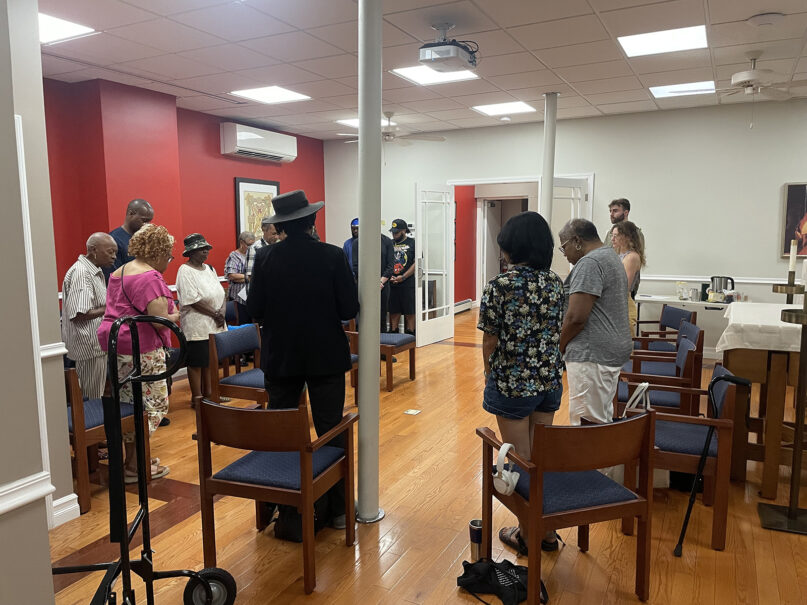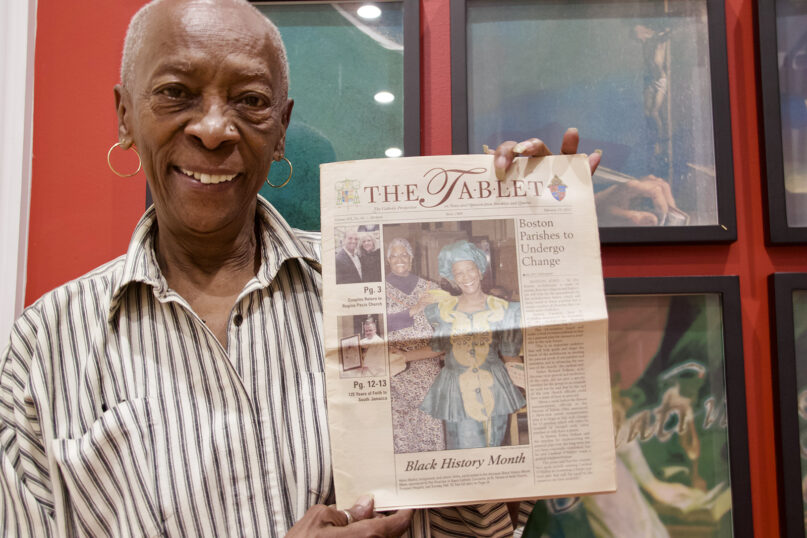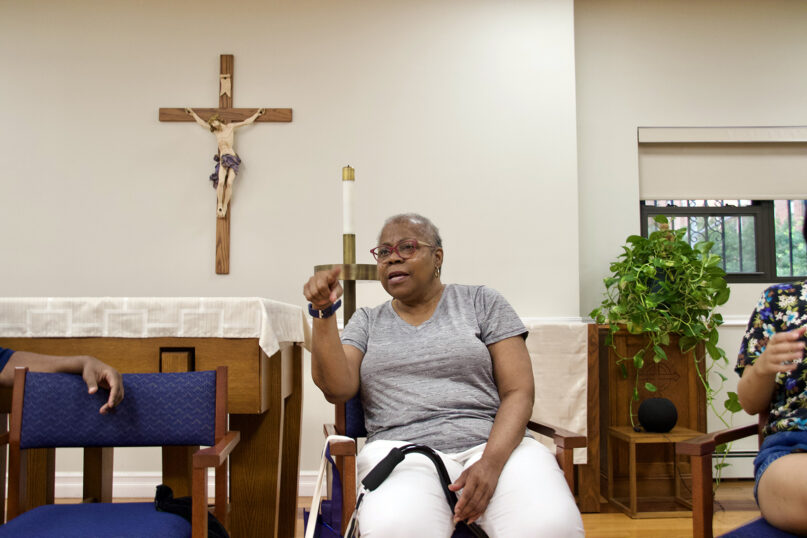
NEW YORK (RNS) — Around 20 parishioners gathered at the Jesuit Community Chapel in Brooklyn on Thursday evening (July 3). The chairs were arranged in a circle, and the mood was purposeful but warm. Two community members acted as translators in Creole and in Spanish as organizers took turns standing to speak.
The group, part of a growing resistance to the planned closure of St. Teresa of Avila Church in Crown Heights, has held weekly meetings since early June, when the church’s rector, Fr. Christopher Heanue, read aloud a letter from their bishop announcing the closing of the church. The ad hoc committee, made up largely of longtime Brooklyn residents within this Caribbean-American community, is determined to fight for a church many members have called home for decades.
“God’s house must always prevail, particularly in these times when people have nothing,” said Denise Caldwell, a longtime parishioner and a co-chair of the group formed to reverse the Bishop’s decision. They have been meeting in the Jesuit Community Chapel, about a half mile away from St. Teresa of Avila, because, Caldwell said, “we were locked out of the church.”
On the first Sunday of June, Pentecost Sunday, Bishop Robert J. Brennan wrote a letter to the church “to share the difficult news that we have determined that the church building must close at the end of this calendar year.” His letter announced that Masses would be scaled back starting July 1 and added, “While I know that these decisions will be hard for you to accept, I want to explain the reasons behind it and to commend the faithful, effective work that has been done at this church for decades.”
Over the past decade, Crown Heights has undergone significant demographic shifts amid rapid growth in New York City’s housing market. Between 2010 and 2020, North Crown Heights lost nearly 19,000 Black residents while gaining approximately 15,000 white residents, according to 2020 Census data released in 2021. During that time, many neighborhoods in Brooklyn, including Crown Heights, saw home prices double.
Mike Delouis, 39, was the cantor at St. Teresa of Avila and had been baptized there after his parents immigrated to Brooklyn from Haiti in the 1970s. “I really liked to see the new faces that were coming in, even through the process of gentrification,” Delouis said. He first heard the news of the church’s closure from the choir loft on Pentecost morning. “We only had the closing hymn left to sing, and it was hard to do it,” he said. “It’s devastating.”

Parishioners gather to strategize protesting the planned closure of St. Teresa of Avila Catholic Church at the Jesuit Community Center on Carroll Street in Brooklyn, Thursday, July 3, 2025. (RNS photo/Fiona Murphy)
The Bishop’s letter cited mounting financial challenges, dwindling participation and a deferred repair bill estimated at $5.5 million. But participants in the group are not convinced and have circulated fliers in the surrounding neighborhood since the announcement, reading: “Help Save Saint Teresa of Avila. The Church Is At Risk of Closing. But Money Is Not the Problem.”
“Young people are coming back to church now, and that makes a difference,” said Myke Mathis, who had attended St. Teresa since 1967. “It’s a necessity in the neighborhood. … We had a soup kitchen, we had a pantry, we had AA people, we had narcotic anonymous people. It’s a vibrant church.”
Chris Campo, 26, was helping organize community testimonials about the church. He said that while visiting Crown Heights one Sunday, the sound of St. Teresa’s bells called him back to his faith. “I moved to this neighborhood because I liked the church’s vibe,” Campo said. “I went to Mass the first Sunday after moving here, and they were playing all the same music as the church I had back home.”
Constructed in 1874 by Italian and Polish immigrants, St. Teresa of Avila was built by hand, including its lower church, altars and exterior masonry. In the 1970s, the parish became the first in the United States to offer Mass in Haitian Creole, drawing migrants fleeing political turmoil in Haiti. Many parishioners told RNS they believe this helped shape Crown Heights into a hub of Haitian and Caribbean life. Today the church complex comprises five structures: the main church, a rectory, a convent, a former boys’ and girls’ school and a parish reception hall.

Myke Mathis holds a Tablet newspaper featuring her on the cover from a 2011 dance party at St. Teresa of Avila Church, during a meeting protesting the church’s closure on July 3, 2025, in Brooklyn, NY. (RNS photo/Fiona Murphy)
The heart of the church is topped by a blue dome above the altar, where a luminous image of Christ sits with an arm raised in blessing. The lower church once displayed 14 oil paintings of the Stations of the Cross, said to have been painted by an artist who also worked for the Vatican. A pipe organ with landmark status remains in disrepair. Original stained-glass windows and hand-carved devotional statues still decorate the sanctuary.
Sharon Lewis, a 53-year-old Brooklyn native, said the closure of St. Teresa felt painfully familiar. A decade ago, she had been a parishioner at St. Ignatius, a Creole-speaking church in the same neighborhood that was merged with another church before being sold and demolished to make way for new housing. “I’m like, not again!” Lewis said. “We didn’t have any meetings to try to save St. Ignatius. It was devastating. When I found St. Teresa, I was so happy to find a second home. So, this is really hard.”
A study by the Center for Applied Research in the Apostolate (CARA) at Georgetown University found that, between the 1970s and 2010s, parish closures and consolidations disproportionately affected neighborhoods with higher rates of poverty and larger populations of Black and Latino residents.
Churches in these neighborhoods often face challenges like aging buildings, rising maintenance costs and declining membership, especially in areas undergoing gentrification. With limited income from parishioner donations, dioceses across the country are making difficult decisions that can result in closures, even for parishes that hold historical and cultural significance.
Bishop Brennan’s letter acknowledged the work of Fr. Heanue and modest gains in Sunday attendance, which averaged 195 people in 2024. But the bishop also cited a decline in baptisms and the growing administrative burdens on clergy, many of whom now oversee multiple parishes.
While the formal closure wasn’t announced until June, parish council members said the diocese first informed them in early April that St. Teresa was “under review” alongside other parishes in Brooklyn. Despite this alert, parishioners said the June announcement and the quick rollout of the scaled‑back Mass schedule still felt abrupt.
Now, the group opposing the closure launched a formal appeal with the Vatican and is collecting notarized letters and testimony. “We are doing everything, you know, in a systematic format,” Caldwell said.

Denise Caldwell leads a gathering of parishioners discussing the potential closure of St. Teresa of Avila Catholic Church, at the Jesuit Community Center on Carroll Street in Brooklyn, Thursday, July 3, 2025. (RNS photo/Fiona Murphy)
At the July 3 meeting, parishioners discussed printing more fliers to raise awareness about the church’s closure and asking local businesses to post them. Toward the end, one member of the group passed around a small stack of old newspaper clippings and photographs from dances and community events once held at the church.
“I tell people, stop saying they’re going to close St. Teresa! Say they want to close St. Teresa,” said Mathis. “I said, but you know what? I got faith. I don’t have no fear. I only have faith.”
